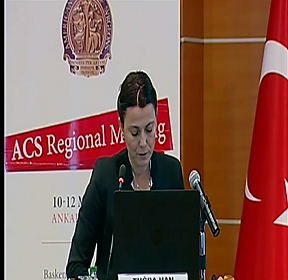Speakers
Dr Hana Damirji
United KingdomTitle: An Evaluation of Morphine Use in Obstetrics During a National Shortage of Diamorphine: A Re-Audit Highlighting Changes in Practice Over Time
Abstract:
An Evaluation of Morphine Use in Obstetrics During a National Shortage of Diamorphine: A Re-Audit Highlighting Changes in Practice Over Time
Introduction: Since the national shortage of diamorphine began in late 2018, preservative-free morphine has been used as an alternative adjunct to local anaesthetics in intrathecal blockade in obstetrics. An initial departmental audit following this enforced change to morphine established a statistically significant increased risk of PONV and reduced patient satisfaction compared with previous diamorphine use. A statistically significant link between intrathecal morphine and reduced post-operative oramorph use was also found. These finding correlate with the different pharmacodynamic profiles of the two drugs. The aim of our re-audit was to evaluate the way in which morphine use changed over time, following our initial audit feedback and with increased familiarity, within our department.
Methods: All obstetric anaesthetic interventions at the Lister Hospital are routinely recorded electronically on the Xentec Epidural Audit System. Data is collected on completion of the procedure and during a post-procedure follow-up 1-3 days later. Data points collected immediately post-procedure include choice of intrathecal opiod and adequacy of block intra-operatively. On follow-up data collected includes overall patient satisfaction, side-effects experienced (including severe PONV and pruritis) and post-operative oramorph requirement. Parturients undergoing intrathecal blockade with morphine (n=104) between 13/07/18 and 20/09/18 had been previously audited. This data set represented the initial use of intrathecal morphine as an alternative to diamorphine: Morphine 1. Upon completion, these audit findings were presented at a local departmental meeting where results were displayed with no protocolised changes suggested or enforced. Post-presentation and following a period of time, a second data set was taken analysing parturients undergoing intrathecal blockade with morphine between 05/09/19 and 01/03/20 (n=374): Morphine 2. Data from these two audit sets were then analysed for comparison.
Results: Statistical analysis was carried out using Chi-Squared tests and results deemed significant if p < 0.05. There was a statistically significant increase in overall patient satisfaction and regional adequacy in the Morphine 2 group versus Morphine 1, with p values of 0.0006 and 0.0051 respectively. However, no statistically significant change was seen in incidence of severe PONV and pruritis or in post-operative oramorph requirements between the two groups.
Conclusions: The results above show an overall improvement in patient satisfaction and intra-operative adequacy of intrathecal blockade with morphine use over time. This most likely represents an increased familiarity with intrathecal morphine use as well as changes in practice following presentation of the initial audit results. Practitioners have reported modifications in terms of morphine dosing and/or addition of a second intrathecal adjust, fentanyl. The later agent has the benefit of augmenting the regional blockade more rapidly than morphine whilst not significantly contributing to side-effects experienced. Furthermore, this may account for the lack of change in post-operative oramorph requirement despite a statistically significant improvement in intrathecal block adequacy. Future audits should focus on comparing specific doses of intrathecal morphine and use of a second opiod adjunct.
Biography:
Dr. Hana Damirji is an anaesthetics and intensive care trainee currently working at the Lister Hospital in Stevenage, UK. She completed her medical training in London, graduating from University College London in 2015 with distinction and also obtaining first class honors in Neuroscience iBSc. Previous publications include the initiation of a debriefing session for intensive care trainees, which NHS Improvement listed as one of the top 10 quality improvement measures of 2017.
Dr Avneet Kaur
IndiaTitle: Constellation of Rare Complications Following Acute Pancreatitis : A Case Report
Abstract:
Constellation of Rare Complications Following Acute Pancreatitis : A Case Report
Acute pancreatitis is characterised by inflammation of pancreas which can be of varying severity depending on the local and systemic complications. An enterovesical fistula is an extremely rare complication of necrotising pancreatitis. Pseudoaneurysms are another rare set of complications associated with pancreatitis that can occur due to the pancratic enzymes eroding the surrounding planes. This case involves the simultaneous presence of these uncommon conditions in a single patient. A chronic alcoholic patient presented to the ED with pain in left lumbar region associated with obstipation, bilious vomiting and fever. A CT scan of abdomen was done which reported necrotic area within body and tail of pancreas involving less than 30% area with multiple hypodense peripherally enhancing collections in anterior pararenal space along with left paracolic gutter and left supramesocolic space. Another collection was seen in superior to dome of bladder with adjacent clumped distal jejunal loops which showed extravasation of oral contrast in the collection. The collection communicated with the bladder with a tract that measured 15.5 mm, suggestive of an enterovesical fistula. The patient was managed conservatively with TPN and an ultrasound guided pigtail catheterization of suprapubic collection to control the intra- abdominal collection. The output through the pigtail catheterization gradually decreased and the urine output became clearer. The patient developed two episodes of hematemesis. It was decided to proceed with a CT angiography that revealed a wide necked splenic artery pseudoaneurysm with no extravasation. Urgent coil embolization of the artery was done. Patient is now doing well.
Biography:
Dr. Avneet Kaur is a general surgery postgraduate resident at VMMC and Safdarjang Hospital, New Delhi. She has an avid interest in the research and enthusiastic about surgical oncology. She is curious about the unusual presentations of the diseases and has been an active member of the conferences organized by the institution.
Tugba Han Oner
TurkeyTitle: Assessing the Burden of Abdominal Tuberculosis in Current Scenario: A Retrospective Single-Centre Study in India
Abstract:
Neutrophil / Lymphocyte Ratio (NLR) – Trombocyte / Lymphocyte Ratio (TLR): A Predictor of Axillary Lymph Node Metastasis in Breast Cancer Patients?
Background: This study evaluated the relationship between preoperative neutrophil / lymphocyte ratio - platelet / lymphocyte ratio, clinicopathological, radiological factors, and axillary lymph node metastasis in stage I-III breast cancer to determine if axillary surgery can be safely omitted in selected patients.
Methods: The study included 158 Stage I-III breast cancer patients operated on at Baskent University Zubeyde Hanim Research Center between 2011 and 2018. The incidence of axillary lymph node metastasis was correlated with clinical, radiological, pathological, and laboratory (neutrophil count to lymphocyte count, platelet count to lymphocyte count) findings by univariate and multivariate analyses. Sensitivity and specificity calculations, positive predictive value, negative predictive value, positive and negative Likelihood Ratio (accuracy ratio), and exact accuracy were calculated for neutrophil/lymphocyte ratio cut-off values of 3.5 and 1.
Results: Neutrophil and platelet values were significantly higher in patients with lymph node metastasis. Neutrophil / lymphocyte ratio - platelet / lymphocyte ratio values were higher in patients with axillary lymph node metastasis, but this was not statistically significant. Axillary lymph node metastasis was not associated with age, lymphocyte, monocyte count, estrogen receptor, progesterone receptor, or c-erb B2 status. The incidence of axillary lymph node metastasis was statistically significantly higher in the presence of lymphovascular invasion. Sensitivity, specificity, positive predictive value, and negative predictive value were 93.85%, 16.67%, 44.9%, and 78.9% respectively for axillary lymph node metastasis while the neutrophil / lymphocyte ratio was ≥ 3.5. Specificity, sensitivity, positive predictive value, and negative predictive value were 97.78%, 9.23%, 75.0%, and 59.9% respectively for axillary lymph node metastasis while the neutrophil / lymphocyte ratio < 1.
Conclusions: For axillary lymph node metastasis, neutrophil, platelet counts, lymphovascular invasion status, radiological and pathological mass size, and presence of radiological axillary lymphadenopathy are the statistically significant independent variables. They provide information that can help surgeons decide on the treatment of breast cancer patients with certain neutrophil / lymphocyte ratio values (neutrophil / lymphocyte ratio < 1 and neutrophil / lymphocyte ratio ≥ 3.5).
Biography:
Tuğba Han Öner works as a General Surgery specialist in İzmir Başkent University Zübeyde Hanım Application and Research Center in İzmir Karşıyaka district.



